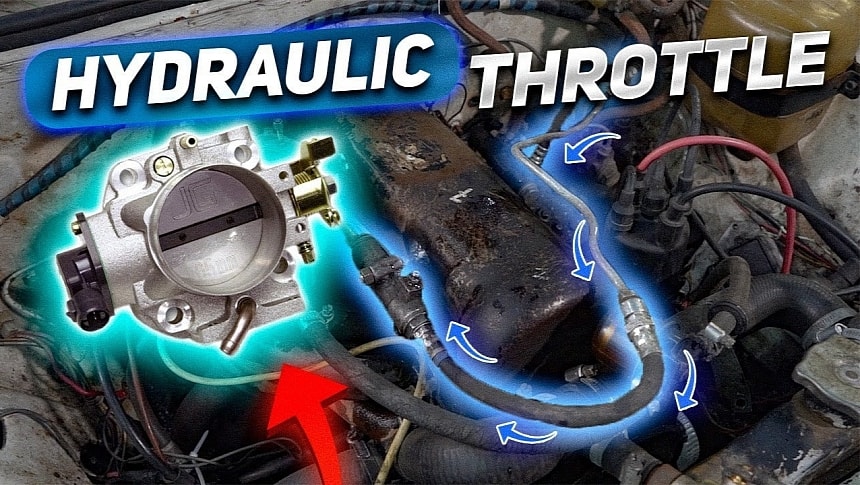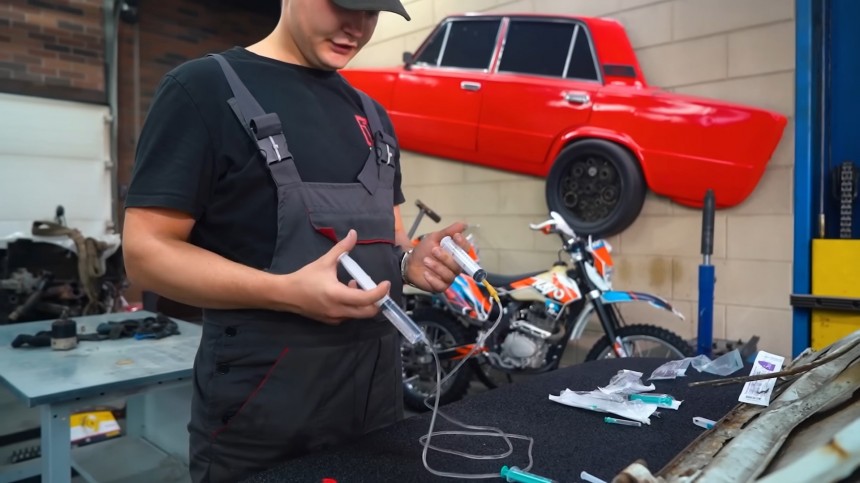Did you check your throttle fluid recently? Is the hydraulic accelerator line sealed properly, or is it leaking here and there? Wait, what? You only have a mechanical linkage between the loud pedal and the go-fast gear under the hood? That’s because carmakers skipped this approach in their design and engineering for mainstream cars. However, a certain group of ‘workarounders’ in the heart of Asia that have now come to remedy the issue.
The jolly fellows from Garage 54 in Novosibirsk, Siberia, Russia, say ‘Hi!’ to us again by coming up with another head-scratching contraption that’s genially against the trends. The brainiacs from the Far East have removed the traditional cable assembly from an old Soviet-era Lada and fabricated a hydraulic-actuated system instead.
The idea is not new – using fluids to convey motion from one end of the setup (namely, the gas pedal) to the other (which, in this case, is the carburetor). The fuel system is irrelevant since the Russians’ setup works either way. Using a hydraulic actuator from a clutch, the Siberians achieved their goal – the car works perfectly fine.
It works even better since the fluid inside the throttle line doesn’t react to the car’s vibrations when the driver runs into potholes, and the throttle response is more accurate and smoother than in the classic cable linkage. Vladimir Barashenko, the frontman for the team of wrench gremlins from Garage 54, doesn’t say if the gas pedal has the same feel as the clutch pedal, given that they now share identical hydraulic systems. I would assume not since the force of the pressure plate of a clutch is much stronger than that exerted by the throttle linkage spring.
For some strange reason, this idea has never made it to mass production, even though hydraulics have been used in automobiles for a long time. I’m not talking about heavy machinery where hydraulic oil is a mainstay – that has some undesirable side effects due to the extreme conditions in which it operates. In a passenger car, the hydraulic systems – any of them – work at low pressures, compared to what excavators, bulldozers, earthmovers, and whatnot develop.
In a standard hydraulic architecture, pressure and temperature are major factors to wear and tear—seals may sear, hoses and lines can corrode and snap, pumps can break down, and so on. However, in this Garage 54 scenario, none of the above applies. Hypothetically, a hydraulic accelerator linkage could work indefinitely without maintenance.
The Russians poured brake and clutch fluid into the throttle master cylinder; in theory, it should behave like it does in the brake system, minus the obvious disadvantages caused by overheating from heavy use over long periods. With no source of friction to generate the amount of heat necessary to bring the fluid to a boil, the hydraulic throttle could operate for decades – if the car makes it that long, without a single flaw.
So, to make one, you’d need two different-size pistons, brake fluid, hoses, lines, seals, couplings, a bit of elbow grease, and a test mule that you don’t care about at all in case anything doesn’t go according to plan or to the video instructions below.
The idea is not new – using fluids to convey motion from one end of the setup (namely, the gas pedal) to the other (which, in this case, is the carburetor). The fuel system is irrelevant since the Russians’ setup works either way. Using a hydraulic actuator from a clutch, the Siberians achieved their goal – the car works perfectly fine.
It works even better since the fluid inside the throttle line doesn’t react to the car’s vibrations when the driver runs into potholes, and the throttle response is more accurate and smoother than in the classic cable linkage. Vladimir Barashenko, the frontman for the team of wrench gremlins from Garage 54, doesn’t say if the gas pedal has the same feel as the clutch pedal, given that they now share identical hydraulic systems. I would assume not since the force of the pressure plate of a clutch is much stronger than that exerted by the throttle linkage spring.
In a standard hydraulic architecture, pressure and temperature are major factors to wear and tear—seals may sear, hoses and lines can corrode and snap, pumps can break down, and so on. However, in this Garage 54 scenario, none of the above applies. Hypothetically, a hydraulic accelerator linkage could work indefinitely without maintenance.
The Russians poured brake and clutch fluid into the throttle master cylinder; in theory, it should behave like it does in the brake system, minus the obvious disadvantages caused by overheating from heavy use over long periods. With no source of friction to generate the amount of heat necessary to bring the fluid to a boil, the hydraulic throttle could operate for decades – if the car makes it that long, without a single flaw.
So, to make one, you’d need two different-size pistons, brake fluid, hoses, lines, seals, couplings, a bit of elbow grease, and a test mule that you don’t care about at all in case anything doesn’t go according to plan or to the video instructions below.


























